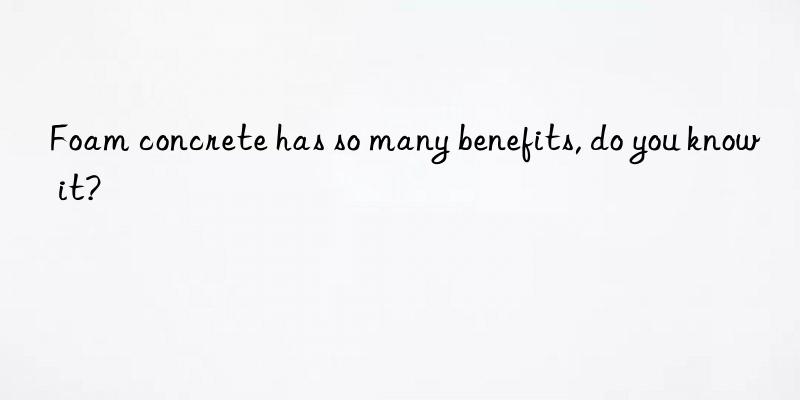
ourselves. The pumping system of the foaming machine performs cast-in-place construction or mold forming, and is formed by natural curing as a new lightweight insulation material containing a large number of closed pores; foamed concrete is made of foaming agent, cement, fly ash, and stone powder. It is a double set of continuous polymers that are mixed into organic cement and contains uniform pores; foamed concrete is an energy-saving material used for roof insulation and slope finding, ground insulation cushion, upturned beam foundation pit filling, wall pouring and other energy-saving materials. It is a bubble-like thermal insulation material, and its outstanding feature is the formation of closed foam pores inside the concrete, making the concrete lightweight and thermally insulating.
1. Characteristics of foamed concrete
Foamed concrete is usually prepared by mechanically preparing a foaming agent aqueous solution into foam, and then the foam is added to siliceous materials, calcium materials, water and A porous material made from a slurry composed of various additives, etc., which is mixed, stirred, cast, and cured. Because foamed concrete contains a large number of closed pores, it has the following good physical and mechanical properties.
1. The density of lightweight foamed concrete is low
The density level is generally 300-1800kg/m3. The density level of commonly used foamed concrete is 300-1200kg/m3. In recent years, the density has been Ultra-light foam concrete of 160kg/m3 has also been used as foam concrete in construction projects. Due to the low density of foam concrete, the use of this material in internal and external walls, floors, floors, columns and other building structures of buildings can generally reduce the weight of the building by about 25%, and some can reach 30% of the total weight of the structure. %-40%. Moreover, for structural components, if foamed concrete is used instead of ordinary concrete, the component's interception capacity can be improved. Therefore, the use of foamed concrete in construction projects has significant economic benefits. In particular, the recent "Eleventh Five-Year Plan" "Medium and Long-term Specialized Plan for Energy Conservation" has set specific goals for the domestic construction industry to achieve energy conservation, and the energy conservation standard coefficient has been increased to 65%. This makes the building energy conservation market potential huge.
2. Good thermal insulation performance
Because foamed concrete contains a large number of closed small pores, it has good thermal performance, that is, good thermal insulation performance. This It is something that ordinary concrete does not have. Generally, foamed concrete with a density level in the range of 300-1200kg/m3 has a thermal conductivity between 0.08-0.3w/(m·K), and the thermal resistance is about 10-20 times that of ordinary concrete. Using foamed concrete as building wall and roof materials has good energy-saving effects.
3. Good sound insulation and fire resistance
Foam concrete is a porous material, so it is also a good sound insulation material. This material can be used as a sound insulation layer on the top floors of buildings. Foam concrete is an inorganic material that does not burn and therefore has good fire resistance. When used in buildings, it can improve the fire resistance of buildings.
4. Good overall performance
Foam concrete can be poured on-site and closely integrated with the main project.
5. Low elasticity and good shock absorption
The porosity of foamed concrete gives it a low elastic modulus, so that it has good absorption and dispersion of impact loads. .
6. Strong waterproof performance
The cast-in-place foam concrete has low water absorption, relatively independent closed bubbles and good integrity, which makes it have certain waterproof performance.
7. Good durability
Same as the life of the main project.
8. Convenient production and processing
Foam concrete can not only be produced into a variety of products in the factory, but can also be constructed on-site and directly poured into roofs, floors and wall.
9. Good environmental performance
The raw materials required for foamed concrete are cement and foaming agent. The foaming agent is neutral and does not contain harmful substances such as benzene and formaldehyde, which avoids Environmental pollution and fire hazards.
10. Convenient construction
You only need to use the cement foaming machine to realize automatic operation, and can pump to achieve long-distance transportation with a vertical height of 200 meters, and the workload is 150-300 cubic meters /working days.
2. Application scope of foam concrete
1. Find slope for roof insulation;
2. Ground insulation cushion;
3. Filling the foundation pit of the upturned beam;
4. Wall pouring;
5. It can be used as retaining walls, construction of stadiums and track and field tracks, as sandwich components, and can also be used as support for composite wall panels, pipeline backfills, and storage tank feet. It can also be used for insulation filling of firewalls and soundproof floors. Filling, tunnel liner backfilling; and isolation of power supply and water pipelines.
6. Filling of cellars, basements and vaults
7. Filling of sewers (both large and small holes are acceptable), filling of storm drains
8. Bridges Body reinforcement, filling, bridge deck repair
9. Heightening of horizontal floors, underground filling
10. Construction of water storage tanks and fuel tank construction 11.Filling and patching of railway platforms. </p



 微信扫一扫打赏
微信扫一扫打赏
